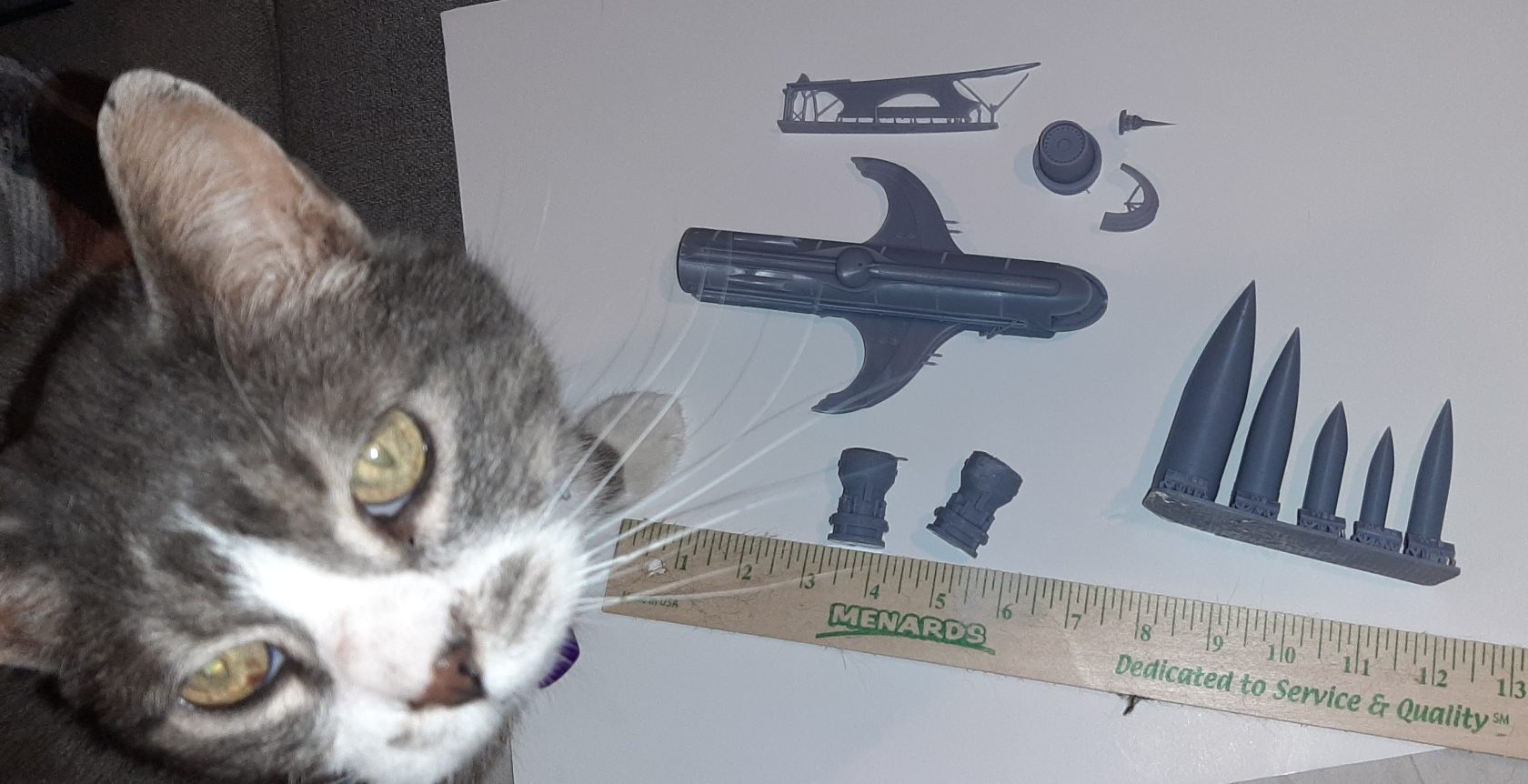Via the University of Alabama, Huntsville archive, a 1942 cutaway diagram of the German A-4 (“V-2”) ballistic rocket.
I’ve uploaded the full rez version into the 2024-06 APR Extras folder for subscribers/patron at the $4 level and above.
So after having the 3D printer for a while and running a *lot* of resin through it, I have achieved some good things. I’ve learned enough to know that there are some things that I plan on producing as full 3D-printed kits, some to be converted into metal castings. I have a few product lines that I want to do:
1: 1/285 (wargaming scale) “minis” of a range of appropriately sized unusual, rare, interesting and projected aircraft/spacecraft
2: “Mini”-sized, but of various scale, aircraft and spacecraft to go with each issue of US Aerospace Projects
3: 1/18 scale models of each American nuclear bomb/warhead/re-entry vehicle. This will range from the downright dinky to the “I’m not sure how to squeeze this out of the printer,” like the Mk 17 and the Flashback. I’ve successfully printed prototypes of the Fat Man and Little Boy A-bombs in 1/18, but they need to be revised.
4: Just whatever strikes my fancy by way of interesting aerospace/sci-fi concepts.
The eventual 3D printed kits will be pricier than if they were cast resin “garage” kits, but this will allow me to make them on demand. I hope there is interest in this sort of thing. To that end, and to help refill my depleted coffers, I’m making available a “crowdfunding” project with three levels. What you will receive are the actual 3D printed components. Each level builds on the prior… Level 2 gets you the Level 1 stuff, Level 3 gets you 1 and 2. No additional postage is required for continental US address… Hawaii, Alaska, Canada, the rest of the world, contact me and I’ll work out the additional postage cost.
Note: many of these are “prototype” kits, with revisions and improvements possible or even probable. And some of these are not planned to be released further. This will be your only chance to get them, at least in this format.
Level 1. You will receive:
1/285 X-20 Dyna Soar spaceplane
1/285 XF-103 Mach 3 interceptor
1/285 Project Pluto nuclear ramjet
1/285 X-15 set (X-15, X-15A2, X-15A3, X-15/SERJ)
1/18 Davy Crockett battlefield atomic warhead w/stand
Crowdfund level 1: $60 in the continental US:
——–
Level 2. You will receive:
1/18 US Atomic Artillery Shells w/stand
1/144 X-20 Dyna Soar
1/18 M61 Vulcan Gatling Gun w/stand
1/18 Mk 72 Nuclear Warhead/Re-Entry Vehicle
Crowdfund level 2: $100 in the continental US:
——–
Level 3. This part will not ship immediately, as some of it remains unfinished. You will receive:
1/285 XF-103 w/missiles
1/350 Orion Nuclear Pulse Vehicle (with stand… not yet finalized)
1/2000 Aldebaran Concept Vehicle
Cast Metal 1/285 X-20 + XF-103 + X-15 + Pluto: Depending on the success of the casting process. Not all are guaranteed.
Crowdfund level 3: $200 in the continental US:
——–
Procured from ebay, this piece of concept art sadly comes without context. It shows a tanker aircraft (pretty much a McDonnell-Douglas YC-15, though the engines appear a bit different… perhaps higher bypass turbofans) topping up an F-15.
The full-rez scan of the art has been made available as a thank-you to APR Patreon and Historical Documents Program patrons at the $4 and above level, placed in the 2024-05 APR Extras Dropbox folder. If interested in this or if you are interested in helping to fund the preservation of aerospace history, please consider becoming a patron, either through the APR Patreon or the Monthly Historical Document Program.
1/350 War Rocket, 1/18 Pulse Units, 1/18 Atomic Artillery Shells.

The War Rocket was modified & printed from a file created for Fantastic Plastic. Their version – currently available – is in much larger 1/144 scale. I was impressed with the tiny details that this smaller print picked up, but the wings are mutated. Two have been printed, both with mucked-up wings. Another round of printing is planned with the models standing straight up to see if that fixes the issue; but since that’ll be a *16* *hour* print job, it’s a low priority.


Buttons horned in on the photography. He’s allowed. He’s old, he was unwell last night, he wanted attention, he gets it. He’s at this moment making typing a challenge for me.

The “pulse units” are actually failed Casaba Howitzers. The telescope components failed rather spectacularly. But with some minimal mods, they’ll make great pulse units for the 10-Meter Orion.

The 1/18 Atomic Artillery Shells have printed numerous times fantastically. They’re basically in production, but the rather simple stand I created for the set refuses to print right. Weird.

I’ve printed off two more Fat Man bombs in 1/18. I can see where improvements can be made to the CAD model, but as is they’ll build up into spiffy little pieces.
Right now I’ve got 2 Fat Man, 2 Little Boy hopefully to sell to help defray costs; if there is interest I can clearly print out more. If interested, let me know. I have two of each right now hopefully to sell to help defray costs; if there is interest I can clearly print out more. So… who wants ’em? $60 per Little Boy, $100 per Fat Man, plus postage. If you want both Little Boy and Fat Man… $150 + postage.
If I refine these for a regular production run, there will be some changes for improved printing, some additional details and importantly stands. But “if” is doing a lot of heavy lifting, and the refined production kits will probably run 1.5 to 2 times as much. 3D printed kits provide options that cast resin kits can’t match, such as complete tail units, but they take many hours each to produce.
![]()
Photos at Twitter:
The two new 1/18 Fat Man units. I can see where improvements can be made to the CAD model, but as is they'll build up into spiffy little pieces. So… who wants 'em? I've got 2 FM, 2 Little Boy. $60 per LB, $100 per FM, plus postage. If interested, let me know. pic.twitter.com/POjyRAyDLF
— Unwanted Blog (@UnwantedBlog) April 30, 2024
1/ Second version of the 1/18 Little Boy. Two fit on the printer at once; both came through with flying colors. the thickened tail surfaces worked like a charm; doesn't seem too out of scale. Flash seems to exaggerate surface imperfections. pic.twitter.com/m8nWg1TdAY
— Unwanted Blog (@UnwantedBlog) April 28, 2024
I’ve been running the 3D printer, with mixed results. Failures and disappointments are the fault of the CAD models; the printer itself (Anycubic Photon Mono X 6Ks) is working as advertised. Printing is not a fast process; some prints took 12 hours.
Some early results with the 3D printer.
First up: some 1/144 and 1/285 X-20 Dyna Soars. Once I got the angle right, the results are pretty spectacular. The 1/285 ones will definitely be used to make metal castings; probably the same with the 1/144. pic.twitter.com/1O2fBWxy2P
— Unwanted Blog (@UnwantedBlog) April 27, 2024
As a lark, I threw in the M61 Vulcan in 1/18 scale, in two orientations. Both seem to have come out looking pretty spiffy, though I haven't trimmed off the supports yet.
Did this just because I wanted to. But if anyone wants one – or more – I can provide. pic.twitter.com/E5NdGp8eCS
— Unwanted Blog (@UnwantedBlog) April 27, 2024
The Casaba Howitzer in 1/18 scale. The original CAD model was created solely to create line diagram illustrations and was in no way optimized for 3D printing, thus the telescope shroud printed funny and fell off. Impressed that it did as well as it did. Model needs revision. pic.twitter.com/XIvNrtSdtT
— Unwanted Blog (@UnwantedBlog) April 27, 2024
Another one thrown in Just Cuz, a 1/350 North American Aviation Mars Excursion Module. Clearly failed, but again the model was not made for printing. The printer made a valiant effort to reproduce the RCS system, with is on hair-thin struts. Not much point in this at this scale. pic.twitter.com/fq6k2hM11k
— Unwanted Blog (@UnwantedBlog) April 27, 2024
1/18 Little Boy, again printed from a non-optimized model. Even so, I'm impressed… the tail was modeled as 3mm thick sheets, and the printer fully replicated that: 0.167 mm thick. Clearly too thin. So currently printing is an updated version. These would make great kits. pic.twitter.com/0D92hWuc0s
— Unwanted Blog (@UnwantedBlog) April 27, 2024
Lastly, two shells from a 1/18 Fat Man. The tail struct has the same issue as little Boy, so it'll need to be fixed before printing. Again I think this'd make a great kit. pic.twitter.com/OoxMmuUpHl
— Unwanted Blog (@UnwantedBlog) April 27, 2024
This is a little outside the usual for APR, as it is satire rather than actual aerospace design. But I thought it appropriate nonetheless; I remember dreaming up just about the exact same ideas when I was twelve. There was something about the design of those pens that just *screamed* for them to be envisioned as spaceships and missiles and whatnot.
The full-rez scan of the article, and a few more bits, been made available as a thank-you to APR Patreon and Historical Documents Program patrons at the $4 and above level, placed in the 2024-04 APR Extras Dropbox folder. If interested in this or if you are interested in helping to fund the preservation of aerospace histgory, please consider becoming a patron, either through the APR Patreon or the Monthly Historical Document Program.
Here are some hypothetical subjects for metal casting as “minis.” I have three pages (standard 8.5X11) of diagrams, all depicting possible subjects at the size they would be at the stated scales. First page shows what I consider a number of interesting designs… not at a constant scale, but size.
Second page depicts a range of Project Orion vehicles again at a roughly constant size. Constant size means, hopefully, a consistent cost.
Third page shows two sets of 8. The US Bomber Projects #1 set has 8 bombers at roughly constant size; US Fighter Projects #1 set has the fighters all at the same scale. 1/285 at least used to be a kind of standard for wargaming, though I’m not sure how widespread it truly was.
Sets like USBP01 would probably all be at about the same price, but those like USFP01 might vary since some designs at quite a bit bigger. What I’m kinda hoping for is the individual minis being about $25 each, while the 8-sets be about $100 each. Thoughts?
These are of course not the full possible catalog, nor would all these here necessarily come to pass. And scales/sizes could vary substantially. A lot of it would depend on actually trying them and see what works, what fails spectacularly.
I’ve achieved a measure of success with getting metal casting up and running. I don’t intend to make too many of these NX-Excelsiors; they’re practice. But I have some spares and can make some more. Anyone interested? Say, $20 plus postage? It is my intention to make some NCC-2000 Excelsiors, and then some NCC-1701-B Enterprises.
BEHOLD WHAT I HAVE CREATED!
I've put the Excelsior into *very* low rate production, mostly just as training. Learned some mold practices that work and some that just don't, but I'm fairly reliably stamping them out. I don't really need a fleet of NX2000s… anybody interested? pic.twitter.com/pOBaSppyGG
— Unwanted Blog (@UnwantedBlog) April 15, 2024
Artwork circa 1983 depicting a one-man combat tiltrotor tearing up a column of Soviet armor. At this time the Light Helicopter – eXperimental program included the possibility of tiltrotors as well as conventional choppers. In the end the RAH-66 won… and was then cancelled before series production. Tiltrotors showed promise, but also promised to be incredibly challenging for a single pilot to manage.